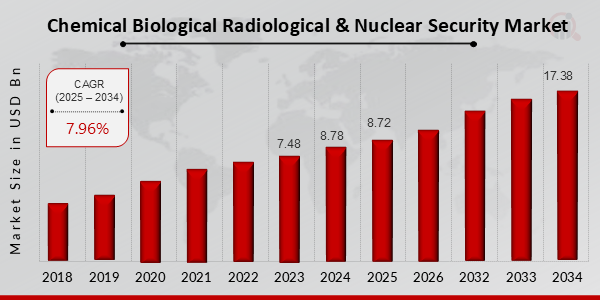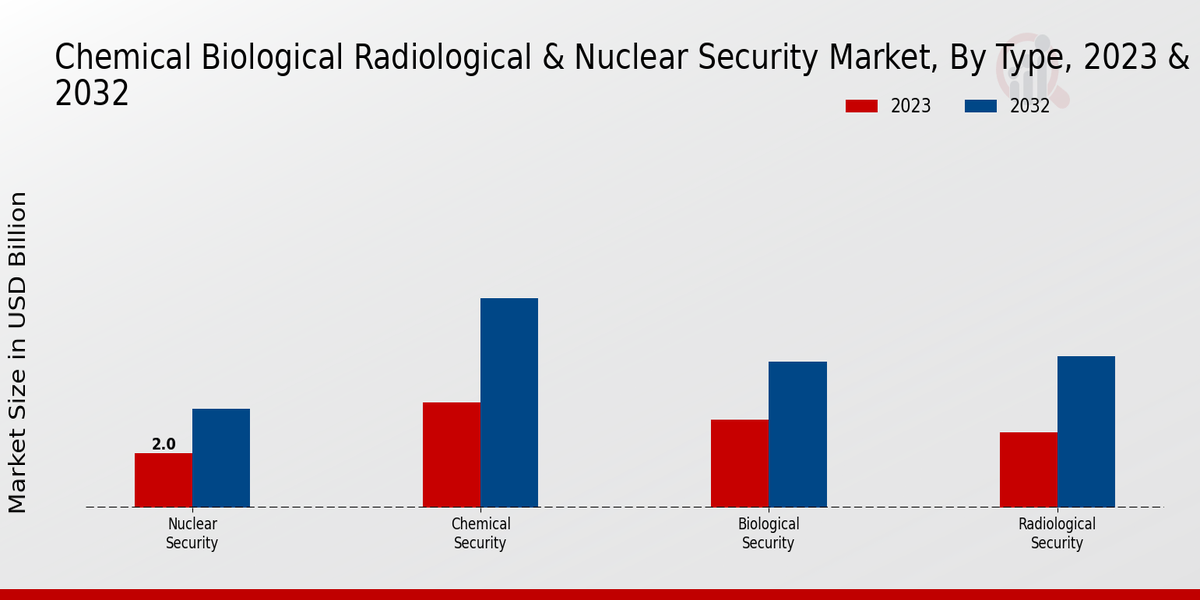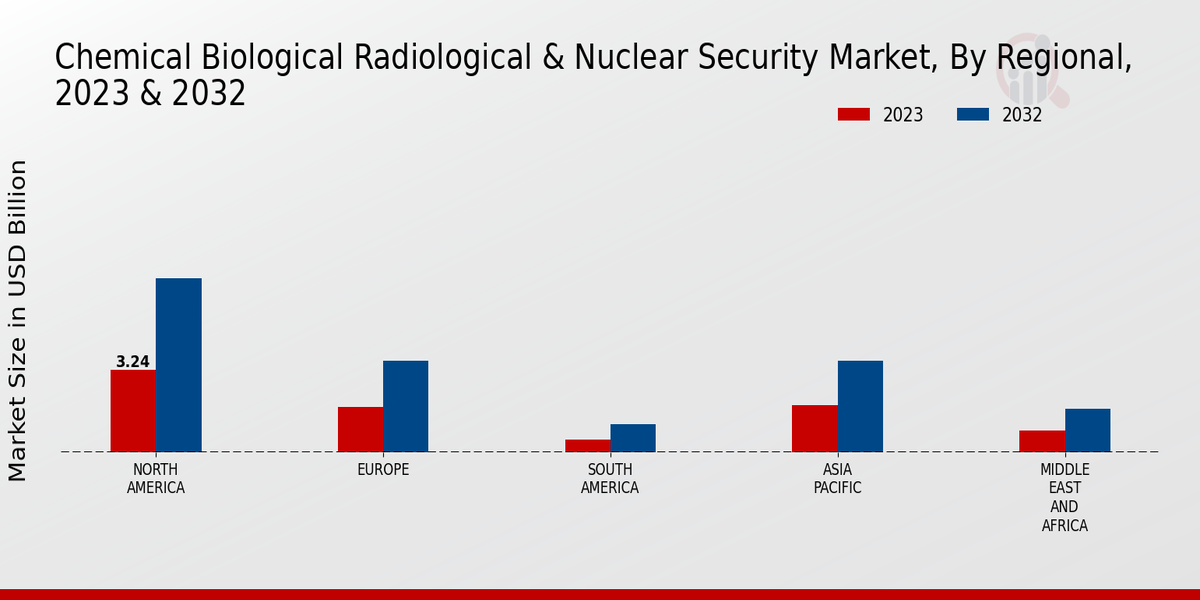Chemical Biological Radiological and Nuclear Security Market Overview
Chemical Biological Radiological & Nuclear Security Market is projected to grow from USD 8.72 Billion in 2025 to USD 17.38 Billion by 2034, exhibiting a compound annual growth rate (CAGR) of 7.96% during the forecast period (2025 - 2034). Additionally, the market size for Chemical Biological Radiological & Nuclear Security Market was valued at USD 8.78 billion in 2024.
Key Chemical Biological Radiological & Nuclear Security Market Trends Highlighted
Advancements in detection technologies, increasing bioterrorism threats, and heightened awareness of CBRN risks are driving the growth of the Chemical Biological Radiological Nuclear Security Market. The market is expected to witness significant growth in the coming years, owing to increased government spending on CBRN preparedness and response measures. Key market drivers include the rise in biological and chemical terrorism incidents, increased focus on border security, and the development of new and improved CBRN detection and response technologies.
Opportunities abound in the development of innovative CBRN detection and protection solutions, as well as the integration of artificial intelligence and advanced analytics into CBRN security systems. Recent trends have seen a surge in demand for remote detection and monitoring technologies, coupled with heightened collaboration between government agencies, law enforcement, and private sector organizations, to address CBRN risks. As global security concerns evolve, the Chemical Biological Radiological Nuclear Security Market is poised to continue its growth trajectory, driven by the need for comprehensive and effective CBRN protection strategies.
Figure 1: Chemical Biological Radiological and Nuclear Security Market Size, 2025-2034 (USD Billion)
 Source: Primary Research, Secondary Research, MRFR Database and Analyst Review
Source: Primary Research, Secondary Research, MRFR Database and Analyst Review
Chemical Biological Radiological Nuclear Security Market Drivers
Increasing Threat of Chemical, Biological, Radiological, and Nuclear (CBRN) Attacks
The rising incidence of CBRN attacks worldwide has fueled the demand for CBRN security solutions. Terrorist organizations and rogue states are increasingly acquiring and using CBRN materials, posing a significant threat to global security. Governments and organizations are investing heavily in CBRN security measures to mitigate these risks and protect their citizens and critical infrastructure. This heightened focus on CBRN preparedness is driving the growth of the Global Chemical Biological Radiological Nuclear Security Market Industry.
Advancements in CBRN Detection and Response Technologies
Technological advancements are revolutionizing the CBRN security landscape. The development of more sensitive and accurate detection systems, improved personal protective equipment (PPE), and advanced decontamination technologies are enhancing the ability to identify, respond to, and mitigate CBRN threats. These innovations are making CBRN security measures more effective and efficient, further fueling the growth of the Global Chemical Biological Radiological Nuclear Security Market Industry.
Growing Awareness and Regulatory Compliance
Increased awareness of CBRN risks and stringent regulatory compliance requirements are driving the adoption of CBRN security solutions. Governments are implementing stricter regulations and standards for CBRN preparedness, requiring organizations to invest in detection, response, and mitigation measures. This regulatory push, coupled with growing public awareness of CBRN threats, is creating a favorable environment for the growth of the Global Chemical Biological Radiological Nuclear Security Market Industry.
Chemical Biological Radiological Nuclear Security Market Segment Insights
Chemical Biological Radiological Nuclear Security Market Type Insights
The Chemical Security segment held the largest market share of 38% in 2023 and is projected to continue its dominance throughout the forecast period. Chemical security focuses on preventing the theft, misuse, or intentional release of chemical weapons or toxic industrial chemicals. With the increasing threat of chemical terrorism and the rise of non-state actors seeking to acquire chemical weapons, governments and organizations are prioritizing investments in chemical security measures. This segment includes technologies for chemical detection, identification, and neutralization, as well as training and response protocols for chemical emergencies.
Biological Security is another crucial segment, accounting for 32% of the Global Chemical Biological Radiological Nuclear Security Market revenue in 2023. Biological security aims to safeguard against the intentional or unintentional release of biological agents that can cause harm to humans, animals, or the environment. The segment encompasses technologies for biological detection, surveillance, and response, as well as measures to prevent the development and proliferation of biological weapons. The radiological Security segment held a share of 20% in 2023 and is expected to witness steady growth over the forecast period.
Radiological security focuses on preventing the theft, misuse, or intentional release of radioactive materials that can pose a threat to public health and safety. This segment includes technologies for radiation detection, monitoring, and response, as well as measures to secure nuclear facilities and radioactive sources. Nuclear Security, representing 10% of the market in 2023, is of paramount importance in preventing the proliferation of nuclear weapons and materials. Nuclear security measures aim to safeguard nuclear facilities, materials, and technologies from unauthorized access, theft, or sabotage.
This growth will be fueled by advancements in detection technologies, the development of new materials and equipment, and increased awareness of CBRN threats among governments and organizations. The market is expected to witness significant investments in research and development, as well as the adoption of innovative solutions to address evolving security challenges.
 Source: Primary Research, Secondary Research, MRFR Database and Analyst Review
Source: Primary Research, Secondary Research, MRFR Database and Analyst Review
Chemical Biological Radiological Nuclear Security Market Product Insights
The product segment of the Global Chemical Biological Radiological Nuclear Security Market is categorized into Detection Systems, Protective Equipment, Decontamination Systems, and Software and Analytics. Detection Systems held the largest market share in 2023, and it is anticipated to continue its dominance throughout the forecast period. The growth of this segment can be attributed to the rising demand for advanced detection technologies to identify and mitigate CBRN threats. Protective equipment, decontamination systems, software, and analytics are also expected to witness significant growth due to increasing investments in CBRN preparedness and response capabilities.
The Global Chemical Biological Radiological Nuclear Security Market is expected to reach USD 13.8 Billion by 2032, exhibiting a CAGR of 7.96% during the forecast period.
Chemical Biological Radiological Nuclear Security Market Application Insights
The Application segment of the Global Chemical Biological Radiological Nuclear Security Market is categorized into Border Protection, Military and Law Enforcement, Critical Infrastructure Protection, and Civilian Security. Among these, the Military and Law Enforcement segment held the largest market share in 2023, accounting for nearly 40% of the Global Chemical Biological Radiological Nuclear Security Market revenue. This dominance is attributed to the increasing demand for CBRN security solutions by armed forces and law enforcement agencies worldwide to combat terrorism and protect national security.
The Border Protection segment is projected to witness significant growth over the forecast period, driven by rising concerns over illegal border crossings and the need for advanced CBRN detection and surveillance systems. The Critical Infrastructure Protection segment is also expected to grow steadily, fueled by the growing emphasis on safeguarding critical infrastructure, such as power plants, water treatment facilities, and transportation networks, from CBRN threats. The Civilian Security segment is anticipated to gain traction due to increasing awareness about CBRN risks and the need for personal protection equipment and decontamination solutions.
Chemical Biological Radiological Nuclear Security Market End User Insights
The Chemical Biological Radiological Nuclear Security Market is segmented by End User into Government Agencies, Military, Law Enforcement, Industrial Facilities, and Healthcare Organizations. The Government Agencies segment is expected to account for the largest market share due to the increasing government spending on CBRN security measures. The Military segment is also expected to witness significant growth, owing to the rising demand for CBRN protection equipment and services by military forces around the world. The Law Enforcement segment is projected to grow steadily, driven by the need to enhance law enforcement capabilities to combat CBRN threats.
The Industrial Facilities segment is expected to witness moderate growth as industries seek to improve their CBRN preparedness and response capabilities. The Healthcare Organizations segment is likely to experience significant growth owing to the increasing demand for CBRN medical countermeasures and protective equipment.
Chemical Biological Radiological Nuclear Security Market Regional Insights
The Global Chemical Biological Radiological Nuclear Security Market is segmented into North America, Europe, APAC, South America, and MEA. North America is expected to hold the largest market share in 2023, owing to the presence of key market players and government initiatives to enhance CBRN security. Europe is expected to witness steady growth due to the increasing adoption of advanced CBRN detection and protection technologies. APAC is expected to exhibit significant growth potential due to rising security concerns and investments in CBRN infrastructure.
South America and MEA are expected to experience moderate growth, driven by increasing awareness about CBRN threats and the need for improved security measures. The Global Chemical Biological Radiological Nuclear Security Market is expected to reach a value of USD 13.8 Billion by 2032, exhibiting a CAGR of 7.96% during the forecast period.
 Source: Primary Research, Secondary Research, MRFR Database and Analyst Review
Source: Primary Research, Secondary Research, MRFR Database and Analyst Review
Chemical Biological Radiological Nuclear Security Market Key Players And Competitive Insights
Major players in the Chemical Biological Radiological Nuclear Security Market industry are continuously focusing on developing advanced technologies and solutions to cater to the evolving threats and challenges in CBRN security. Leading Chemical Biological Radiological Nuclear Security Market players are investing heavily in research and development to enhance the detection, response, and mitigation capabilities of their products and services. The Chemical Biological Radiological Nuclear Security Market is highly competitive, with several established players and emerging startups vying for market share. Key players in the market include companies such as Smiths Detection, Bruker Corporation, FLIR Systems, Honeywell International, and Thermo Fisher Scientific. These leading players are involved in intense competition to gain a competitive edge in the market through strategic partnerships, acquisitions, and product innovations. The Chemical Biological Radiological Nuclear Security Market Competitive Landscape is expected to witness further consolidation and strategic alliances as companies seek to expand their global presence and enhance their product portfolios.
Smiths Detection, a leading player in Chemical Biological Radiological Nuclear Security Market development, offers a comprehensive range of CBRN detection and screening systems. The company's products include explosives trace detectors, chemical and radiological detection systems, and threat assessment tools. Smiths Detection has a global presence, with operations in over 50 countries and a strong track record of providing CBRN security solutions to government agencies, law enforcement, and commercial customers. The company's focus on innovation and customer-centric approach has enabled it to maintain its position as a leading player in the CBRN security market.
Another key player in the Chemical Biological Radiological Nuclear Security Market is FLIR Systems. The company specializes in developing thermal imaging and infrared detection technologies for various applications, including CBRN security. FLIR Systems offers a range of products for CBRN detection, such as thermal imaging cameras, chemical and biological detectors, and radiation detectors. The company's products are used by military, law enforcement, and first responder organizations around the world. FLIR Systems' commitment to innovation and its strong technological capabilities have made it a leading provider of CBRN security solutions.
Key Companies in the Chemical Biological Radiological Nuclear Security Market Include
-
Smiths Group
-
OSI Systems
-
BAE Systems
-
Northrop Grumman
-
Chemring
-
Rheinmetall
-
Raytheon Technologies
-
Safran
-
Thales
-
L3 Communications
-
Lockheed Martin
-
Elbit Systems
-
Cobham
-
Honeywell
Chemical Biological Radiological Nuclear Security Market Industry Developments
The Chemical Biological Radiological Nuclear (CBRN) security market is projected to grow from USD 6.93 billion in 2023 to USD 13.8 billion by 2032, at a CAGR of 7.96% during the forecast period. Rising concerns about terrorism and the proliferation of weapons of mass destruction are driving the demand for CBRN security solutions. Governments worldwide are investing in CBRN defense systems to protect their citizens and critical infrastructure. Recent news developments include the development of new CBRN detection technologies, such as handheld chemical detectors and standoff nuclear radiation detectors. Additionally, there is a growing focus on international cooperation to combat CBRN threats. For instance, the Organization for the Prohibition of Chemical Weapons (OPCW) has been working to eliminate chemical weapons worldwide.
Chemical Biological Radiological Nuclear Security Market Segmentation Insights
-
Chemical Biological Radiological Nuclear Security Market Type Outlook
-
Chemical Security
-
Biological Security
-
Radiological Security
-
Nuclear Security
-
Chemical Biological Radiological Nuclear Security Market Product Outlook
-
Detection Systems
-
Protective Equipment
-
Decontamination Systems
-
Software and Analytics
-
Chemical Biological Radiological Nuclear Security Market Application Outlook
-
Border Protection
-
Military and Law Enforcement
-
Critical Infrastructure Protection
-
Civilian Security
-
Chemical Biological Radiological Nuclear Security Market End User Outlook
-
Government Agencies
-
Military
-
Law Enforcement
-
Industrial Facilities
-
Healthcare Organizations
-
Chemical Biological Radiological Nuclear Security Market Regional Outlook
-
North America
-
Europe
-
South America
-
Asia Pacific
-
Middle East and Africa
| Report Attribute/Metric |
Details |
|
Market Size 2024
|
8.78 (USD Billion)
|
|
Market Size 2025
|
8.72 (USD Billion)
|
|
Market Size 2034
|
17.38 (USD Billion)
|
|
Compound Annual Growth Rate (CAGR)
|
7.96% (2025 - 2034)
|
|
Report Coverage
|
Revenue Forecast, Competitive Landscape, Growth Factors, and Trends
|
|
Base Year
|
2024
|
|
Market Forecast Period
|
2025 - 2034
|
|
Historical Data
|
2019 - 2023
|
|
Market Forecast Units
|
USD Billion
|
| Key Companies Profiled |
Smiths Group, OSI Systems, BAE Systems, Northrop Grumman, Chemring, Rheinmetall, Raytheon Technologies, Safran, Thales, L3 Communications, Lockheed Martin, Elbit Systems, Cobham, Honeywell |
| Segments Covered |
Type, Product, Application, End User, Regional |
| Key Market Opportunities |
Increasing need for CBRN security Advancements in detection technologies Growing demand for protective gear Increased investment in border security Development of new CBRN threat detection systems |
| Key Market Dynamics |
Rising security concerns, technological advancements, government regulations, increasing CBRN threats, and growing awareness. |
| Countries Covered |
North America, Europe, APAC, South America, MEA |
Frequently Asked Questions (FAQ) :
The Global Chemical Biological Radiological Nuclear Security Market is projected to reach a valuation of 8.72 billion USD in 2025.
The market is poised to exhibit a CAGR of 7.96% from 2025 to 2034.
North America is anticipated to hold the largest market share in 2023.
Chemical Biological Radiological Nuclear Security solutions find applications in various sectors, including defense and military, law enforcement, and critical infrastructure protection.
Key players in the market include Lockheed Martin, Northrop Grumman, and BAE Systems.
Rising concerns over terrorism, geopolitical conflicts, and the proliferation of weapons of mass destruction are fueling market growth.
Challenges include the high cost of CBRN defense systems, the need for continuous technological advancements, and the evolving nature of threats.
Trends include the adoption of AI and machine learning, the development of non-lethal CBRN technologies, and the increasing focus on international cooperation.
The market is projected to witness significant growth due to ongoing security concerns and the need for advanced CBRN defense systems.
The market is anticipated to reach a valuation of 13.8 billion USD by 2032.

















